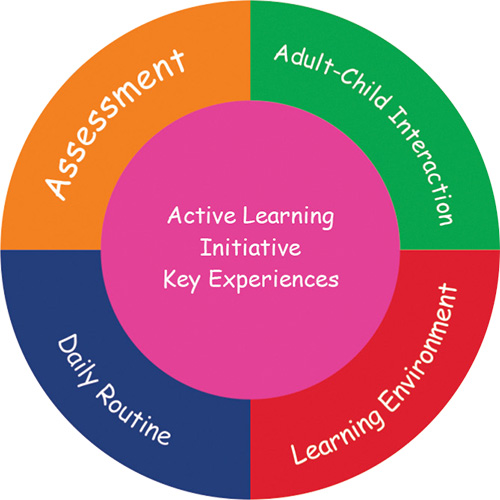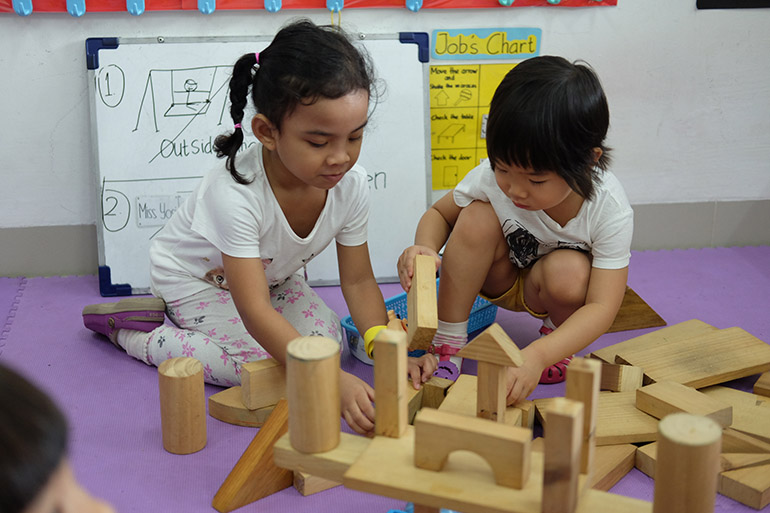Early Childhood Educational Program
Introduction
In HighScope, we believe that education and the building of positive character starts at an early age. Children as young as toddlers start their learning about the world and how to relate with other people. They learn the skills in social and emotional development, by interacting with other children, interacting with objects and interacting with events, guided by teachers who provide continuous support and training in their daily interactions with children.
HighScope Early Educational Program’s approach incorporates 5 elements that function within HighScope’s open framework philosophy. The elements are:
- Active Learning
- Adult-Child Interaction
- Learning Environment
- Daily Routine
- Assessment

Curriculum
At HighScope Indonesia's Early Childhood Educational Program, adults when facilitating children's learning are guided by 58 Key Experiences that support children's development in the physical, social, emotional and cognitive areas.
The Early Childhood Education Program covers subject as follows:
- Approach to learning
- Social & emotional Development
- Physical development & health
- Language, literacy and communication
- Mathematics
- Creative arts
- Science & Technology
- Social Studies
Active Learning
Children are involved in direct, hands-on experiences with people, objects, ideas, and events. These active learning experiences will help children construct their knowledge, i.e. learn concepts, form ideas, and create their own symbols and abstractions. As facilitators, who will also observe and participate in children’s activities, teachers are guided by key experiences that all children need to have as part of their intellectual, physical, social and emotional development.
There are 10 key experience categories:
1. Creative Representation
2. Language and Literacy
3. Social relation and Initiative
4. Movement
5. Music
6. Classification
7. Seriation
8. Number
9. Space
10. Time
The above key experiences lead to:
- Current and long-term social outcomes
- Academic skills needed for school success
Adult-Child Interaction
Adults observe and interact with children at their level to discover how each child thinks and reasons. Adults interact with children in ways that allow children to take control of their own learning. They also support children’s intrinsic motivation in learning by:
- Organizing the routine and environment
- Establishing a supportive social climate
- Supporting constructive conflict resolution
- Interpreting children’s actions in terms of key experiences
- Planning active learning experiences based on children’s interests and abilities
Learning Environment
The classroom is arranged in five or more interest areas. The areas are labeled with simple names that make sense to children, such as “Block Area”, “House Area”, and are clearly defined. The materials are varied, developmentally appropriate, plentiful, open-ended, and related to community/culture. The materials are organized in a way that allows children to find, use them, and return them when they are finished using them. This arrangement supports children in finding and using materials to explore, invent, and learn about their world.
Daily Routine
Each day follows a similar schedule of events, providing a consistent frame work for both children and adults. A daily plan-do-review sequence is at the core of the HighScope daily routine that allows children to independently:
- Pursue interests
- Make plans
- Follow trough on plans
- Reflect on experiences
Besides the above plan-do-review sequence, the organization of the day also allows children to meet in small groups to engage in adult-initiated activities based on children's interests, needs, and developmental levels and to engage in whole-group activities that stress social interactions, music, and physical movement.
Assessment
Assessment is the key for practitioners; it enables them to:
- Understand developmental levels of children
- Identify expressed interests
- Observe the key experiences in which each child engages
Thus, Highscope teachers regularly record notes on children’s behaviors, experiences, and interests. They use these notes to assess each child’s development and to plan activities that will facilitate their growth and development.
This process requires:
- Team planning
- Daily recording of observations
- Quarterly compilation of recorded notes
The notes are also used in parent conferences to help parents better understand their children’s development.
QUALIFICATION
Early Preschool
A child is accepted in the early preschool program if he or she has reached the age of 18 months (1 year and 6 months)
Preschool
- A child is accepted in the preschool program if he or she has reach the age of 30 months (2 years and 6 months) by July 31 of that specific academic year
- Acceptance in the preschool program is conducted by July of that specific academic year
- Should a child reach the age of 30 months (2 years and 6 months) after July 31 (the cut off date) of that specific academic year, he or she will be placed in early preschool program (if seats are available)


